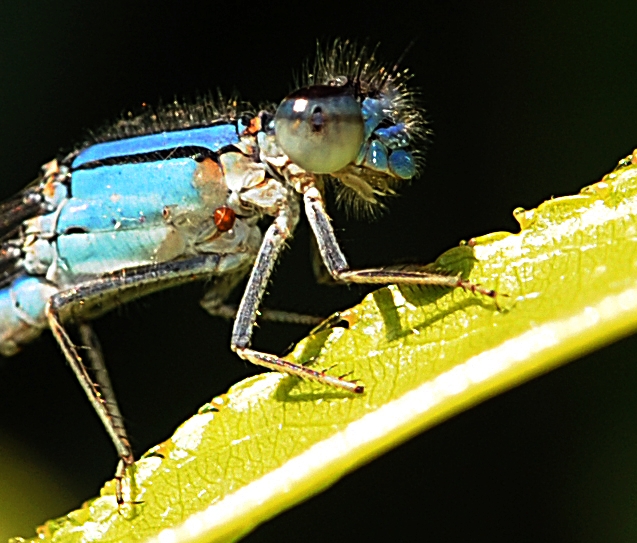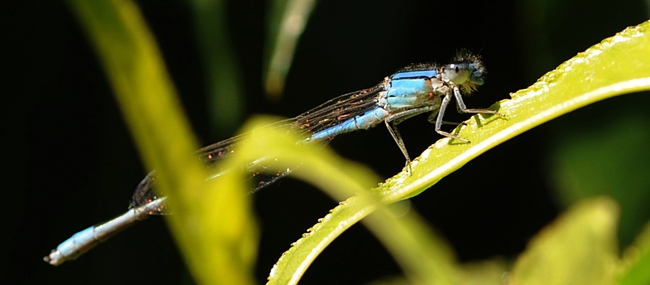- Author: Kathy Keatley Garvey
If you like your insects long, slender and delicate, and resembling a flying neon needle, the damselfly is for you.
Who can resist watching them and photographing them?
The common blue damselfly or Northern Bluet (Enallagma cyathigerum) is as thin as a needle, a jeweled blue needle.
We've seen them hover in our yard, like mini-helicopters--oops, make that "skinny mini" helicopters--and then touch down on a leaf to feast on small insects.
Damselflies share the same order, Odonata, as their larger cousins, the dragonflies. As any entomologist will tell you, damselflies belong to the suborder Zygoptera, and dragonflies, Anisoptera. They are an ancient group, with fossil records showing they existed at least 250 million years ago.
Odonata means "toothed" and Zygoptera means "paired wings."
Damselflies are no "damsels in distress." They're daytime hunters that "consume large quantities of other insects such as flies, mosquitoes and moths and some eat beetles and caterpillars," according to a Texas A&M University (TAMU) website.
Some other facts on the TAMU site:
- In prehistoric times, dragonflies and damselflies were as huge as hawks and were "the largest insects to ever live."
- Worldwide, there are more than 4700 species of Odonata, with Zygoptera accounting for a third fo them
- Males of most damselfly species are brighter-colored than females
- Damselflies neither bite nor sting.
The UC Statewide Integrated Pest Management (UC IPM) describes damselflies this way: "The head is narrow with bulging eyes, long antennae, and tubular-sucking mouthparts. The legs are long and the front pair are slightly swollen with inconspicuous spines. Adults and nymphs can move rapidly when disturbed or stalking prey."
A photography tip: if you spot a damselfly, approach it with your camera already raised. A sudden movement may spook them.
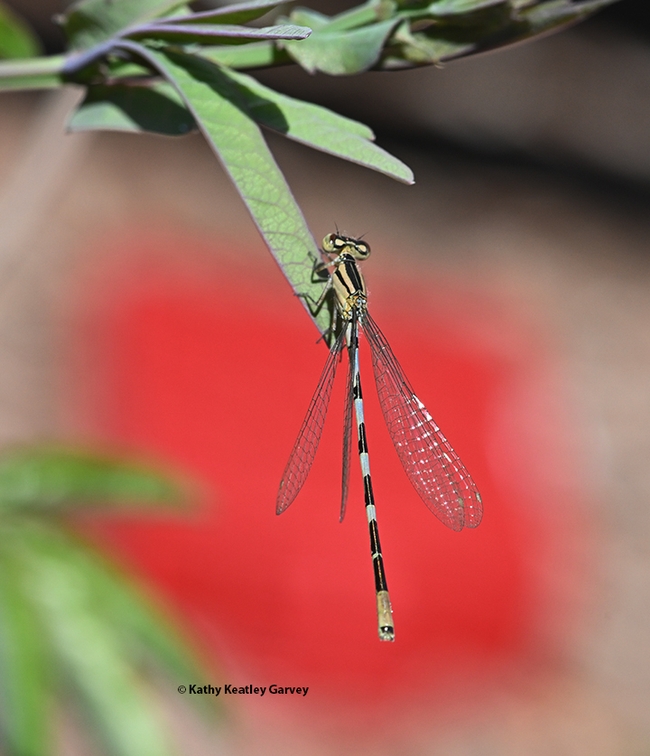
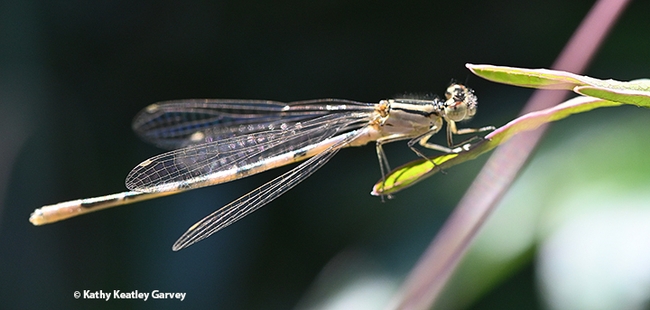
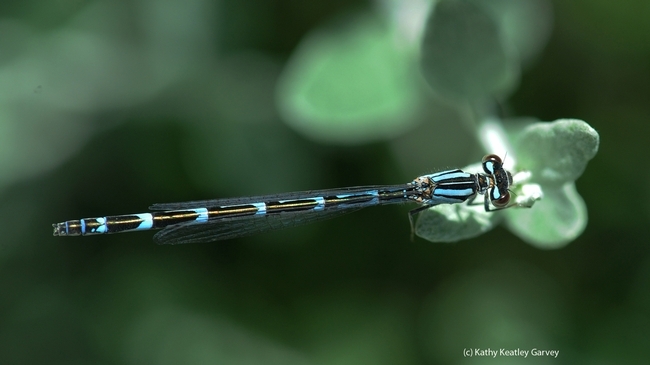
- Author: Kathy Keatley Garvey
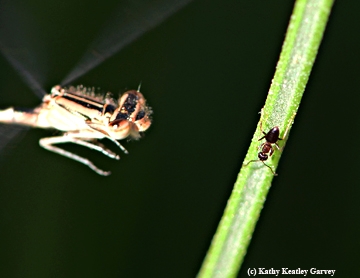
They're so tiny and inconspicuous that they're easy to miss. They're about an inch long and so slender that they look like flying needles.
Like its cousin, the dragonfly, the damselfly (suborder Zygoptera) is a predator that catches and eats flying insects. Flies, knats and mosquitoes are often on their menu.
Damselflies frequent the area near our fish pond and we see them glide in and out of our lavender patch, the catmint, oregano and the Mexican sunflowers (Tithonia). Sometimes they perch on a stem in the early morning and warm their flight muscles.
When we see them, we always look for bright red mites. Red mites? Think of a a cluster of miniature salmon eggs. Some of these damselflies are so heavily parasitized that you wonder how long they'll survive. Damsel in distress?
We've never seen a damselfly actually catch a flying insect, but we did find one last weekend that was quite interested in an ant scurrying down a lavender stem. The damselfly backed up and appeared to be targeting it.
The ant, however, escaped.


- Author: Kathy Keatley Garvey
In the entomological world, we call that a "two-fer."
Two insects in the same photo.
Sunday morning we spotted a fiery skipper butterfly (Hylephila phyleus) on an artichoke leaf. It was warming its flight muscles, maybe to flutter over to the lavender for a sip of nectar.
Next to it--we almost missed it--was a damselfly, apparently doing the same thing. Or maybe it was waiting for an aphid or a gnat or ant to come along. They eat small, soft-bodied insects.
The skipper: a member of the family Hesperiidae, order Lepidoptera.
The damselfly: a member of the suborder Zygoptera, order Odonata.
Two entirely different orders, but both belonging to the class Insecta.
And sharing an artichoke leaf on a Sunday morning.

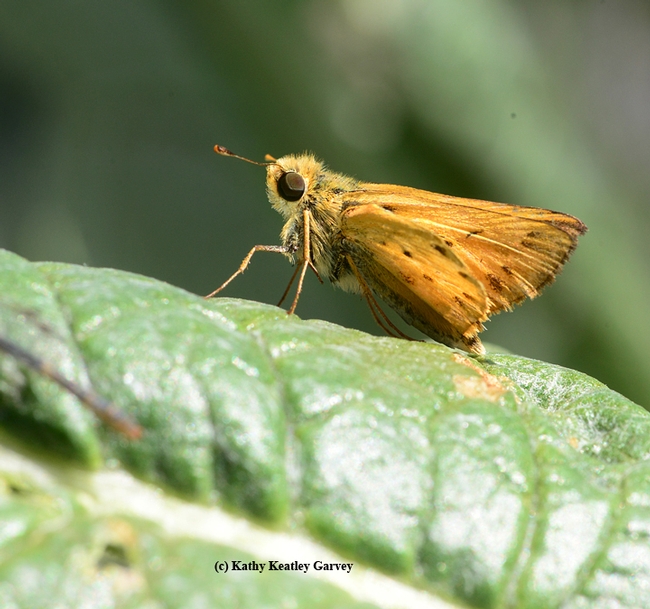
- Author: Kathy Keatley Garvey
Up close and personal, those blue damselflies (suborder Zygoptera, order Odonata) look prehistoric.
Fact is, they were here before the dinosaurs.
These needlelike insects add an iridescent presence as they fly awkwardy over our fish pond, catching prey. In the early morning, they land in our nectarine tree. They're not there to pick nectarines. They're warming their flight muscles.
Their brilliant colors draw us to them. But their huge compound eyes quickly notice us and off they go.
Awkwardly.
